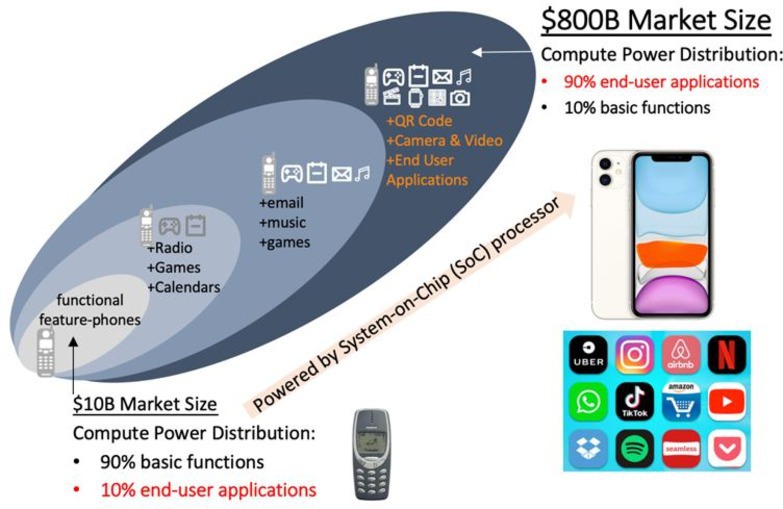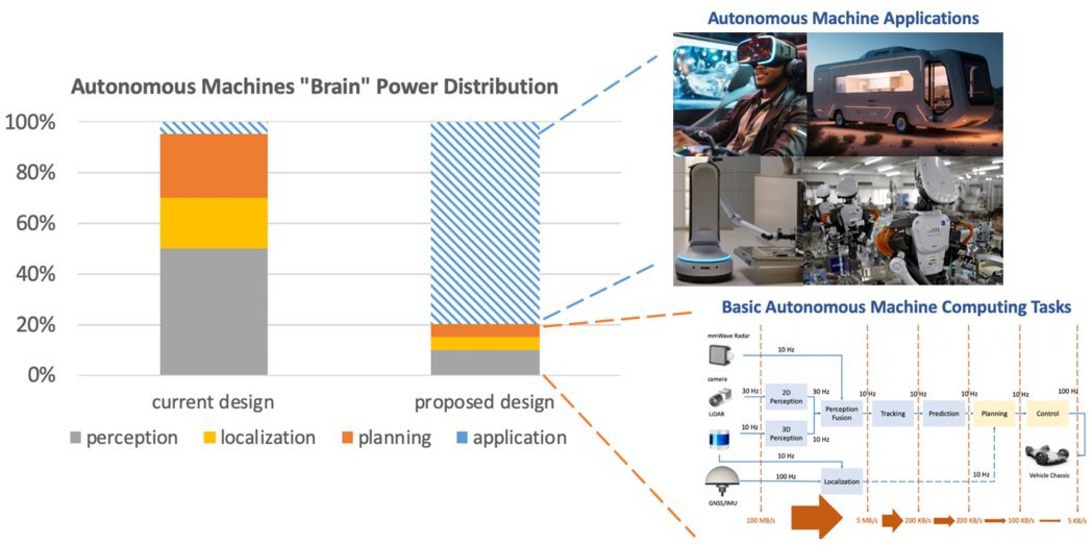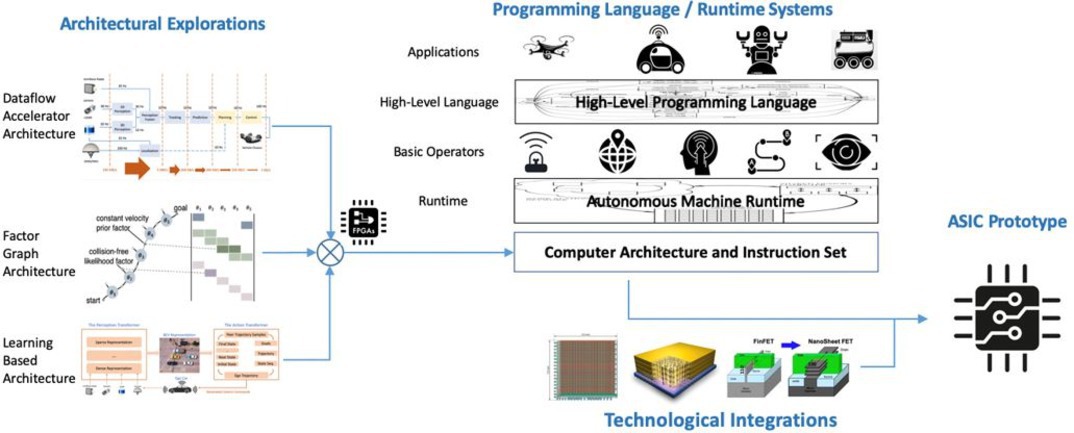The Role of Autonomous Machine Computing in Shaping the Autonomy Economy
https://bit.ly/3x5A6UY
February 1, 2024
The Autonomy Economy represents a transformative phase in our society, driven by the integration of autonomous machines such as autonomous vehicles, delivery robots, drones, and more into the provision of goods and services. Central to this revolution is Autonomous Machine Computing (AMC), the computing technological backbone enabling these diverse autonomous systems. This article delves into AMC’s critical role in fostering the Autonomy Economy.
The ascension of autonomous machines signifies a paradigm shift from the Digital Economy. Originally confined to basic robotics and industrial applications, these autonomous machines now permeate everyday life, signaling a move towards the Autonomy Economy era. For example, in China, when you check into a hotel, it’s likely that a delivery robot is going to bring what you need to your room. When you order food and grocery delivery, in some cities, it’s robots that deliver the food from the restaurant or the supermarket to your doorstep. At home, robotic vacuum cleaners have become standard home appliances.1
In the past decades, the Digital Economy has significantly propelled economic growth. For instance, the internet economy accounts for 21% of GDP growth in mature economies from 2005 to 2010 and contributing $2.1 trillion to the U.S. economy in 2019.2 Compared to the Digital Economy, the Autonomy Economy is poised for an even more profound impact. A key example is the potential transformation of the $1.9 trillion U.S. transportation sector through the widespread adoption of autonomous vehicles, indicative of the sweeping changes across various industries.
Historical insights – The Virtuous Cycle
At the heart of this transition to the Autonomy Economy is AMC. Similar to its predecessors—personal computing and mobile computing—AMC is the core technology stack that empowers a wide range of autonomous machine form factors, including intelligent vehicles, autonomous drones, delivery robots, home service robots, agriculture robots, industry robots and many more that we have yet to imagine. AMC involves sensing technologies, computing technologies, communication technologies, autonomous machine algorithms, reliability and security, and many other technical areas. As of today, AMC is still evolving and being defined.
To elucidate the impact of AMC on the evolution of the Autonomy Economy, let us examine historical precedents. Figure 1 illustrates the correlation between the market sizes of ecosystems and their corresponding semiconductor markets in the realms of personal and mobile computing. Currently, the mobile processor market is valued at $35.1 billion, with the mobile computing ecosystem’s market size soaring to $800 billion—approximately 23 times larger. Similarly, the personal computing processor market stands at $55 billion, with its ecosystem valued at $900 billion, making it 16 times the processor market’s size.3 This pattern indicates that, as a computing era matures, the semiconductor industry plays a crucial role, potentially fostering an ecosystem that is 15 to 25 times its own market size.
These historical insights reveal a fundamental truth: the semiconductor industry acts as a cornerstone for modern economies. The growth of nascent sectors like AMC prompts the semiconductor industry to innovate and develop necessary technologies. These advancements, in turn, fuel further growth in the emerging sector, creating a self-reinforcing cycle of development and expansion. This virtuous cycle underscores the semiconductor industry’s pivotal role in enabling and propelling the growth of sectors critical to the future economy, such as AMC in the burgeoning Autonomy Economy.
Computing power allocation dictates ecosystem size.
The pivotal role of computing power allocation in ecosystem growth is evident in the transformation of the mobile computing industry, as illustrated in Figure 2: In the early 2000s, mobile phones, predominantly feature phones, were widespread yet offered limited functionality, focusing 90% of their computing power on basic communication tasks like encoding and decoding. With less than 10% of computing power allocated for applications, the scope for diverse applications was minimal, constraining the mobile computing ecosystem’s market size to approximately $10 billion.
The advent of smartphones marked a paradigm shift, driving insatiable demand for increased computing power to support a burgeoning array of mobile applications. This demand catalyzed the transformation of single embedded chips into sophisticated mobile systems-on-chip, integrating multi-core CPUs, mobile GPUs, mobile DSPs, and advanced power management systems. This technological leap forward has made 90% of computing power available for applications such as YouTube, WhatsApp, Uber etc., and has expanded the mobile computing ecosystem’s market size to $800 billion today. This trajectory underscores the transformative power of semiconductor technology advancements. By enabling a broader range of applications, these technologies not only enhance existing markets but also pave the way for new ecosystems, scaling the market size to multiples of the semiconductor sector’s value.
Autonomous Machine Computing Challenge
The predominant challenge facing AMC today is the creation of a robust ecosystem, hampered by the limited computing power allocated for AMC applications. As depicted in Figure 3, existing designs of AMC systems heavily prioritizes basic operational functions: 50% of computing resources are allocated to perception, 20% to localization, and 25% to planning. Consequently, this distribution leaves a minimal 5% for application development and execution, significantly restricting the capability for autonomous machines to perform complex, intelligent tasks.
Addressing this issue necessitates a paradigm shift towards an AMC processor architecture that embeds critical computing functions directly into hardware. This approach dramatically liberates computing resources, enabling software developers to devote more attention to creating advanced AMC applications. An optimized design would significantly adjust the current allocation of computing power by integrating the essential tasks of perception, localization, and planning into the hardware itself, thus requiring only a minimal portion of the computing resources—10%, 5%, and 5%, respectively. This reallocation strategy would make an impressive 80% of computing power available for intelligent applications, thereby substantially enhancing the functional capabilities of autonomous machine systems.
This strategy is more than just a technical enhancement; it represents a leap forward in the way we conceptualize and develop autonomous machines. By offering an efficient hardware platform that eases the development of AMC applications, we aim to unlock the creative potential of software developers. This, in turn, is expected to spur the creation of a dynamic marketplace for AMC applications. Ultimately, our vision is to usher in a new era of innovation in autonomous machines, shifting the emphasis from executing basic tasks to achieving advanced, intelligent behaviors, thereby expanding the possibilities of what autonomous machines can accomplish.
Roadmap Forward
As illustrated in Figure 4, unlocking the full economic potential of the AMC ecosystem hinges on the development of advanced computing systems that are easy to program, which involves the following research directions:4 First, establishing a common computing architecture for autonomous machines, akin to the ARM architecture in mobile computing. Over the past five years, we’ve identified three promising architectures—dataflow accelerator architecture (DAA), factor graph architecture (FGA), and learning-based architecture (LBA)—as candidates. Our objective is to integrate their best features into a unified architecture.
Second, developing a programming and runtime system to enable developers to efficiently create AMC applications, overcoming the current challenges of system abstraction, real-time constraints, and reliability guarantees.
Third, the advancement of semiconductor technologies, such as SPAD, 3D stacking, and InP/InGaAs will further enhance AMC’s sensing, computing, and communication capabilities, leading to more innovative applications and a seamless integration of emerging technologies with AMC system architectures.








Join the Discussion (0)
Become a Member or Sign In to Post a Comment